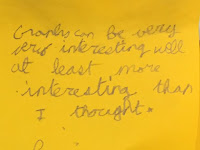This idea though, I think would be useful as a tuning in learning experience for any Unit of Inquiry.
I really like Kath Murdoch 's explanation that the tuning in part of the inquiry cycle is often misconceived as simply tuning kids into the topic. Rather she explains how the tuning in time should be seen as an opportunity for teachers to tune into what the children are wondering and previously know. (She says this much better in her own words. See Kath's blog post here )
We began by looking at our central idea we would be using for this:
The children found two interesting graphs on Google images related to the central idea.
Examining each graph, they recorded interesting data the graph provided about their topic and then wonderings they gained from reading the graph.
It worked really well.
It helped broaden what they could be enquiring into and served as a student-driven provocation.
When we later looked at creating our lines of inquiry, many children used this provocation to form what they wanted to learn. It aroused a lot of curiosity and deep thinking.
Afterwards, we shared our graphs with peers explaining what the graph told us and what it made us wonder. Students not selecting that inquiry topic equally became interested in the graphs and suggested other wonderings they harboured from reading it. This generated a lot of interesting discussions about what they might want to discover.
We then write reflections on post its about what we learnt, discovered or realised about the central idea and we shared and discussed these as a whole class:

= Using graphs as a tool to create your own theories? - love it!

Changing perspective on graphs, well slowly
= what a deep thought!

Changing perspective on graphs
Love this- help you to visualise and understand things more easily
Samples:
This student wants to enquire into connections between the ice age and global warming and the effects of both on wildlife.
In sharing the graphs, she wondered: Does this mean the ice age ended because of global warming?
This is the type of provoking wonderings graphs can help children to formulate.
This student wants to enquire into the effects of colours used in advertising.
At first he wasn't sure if it was a graph or a diagram.
It made a few of us wondering:
This student wants to learn about what goes into pet food and why. She also found a really creative graph:
Even a student enquiring into how the lives of people living in the Stone Age affect our lives today can use a graph to learn and wonder:
This student is wanting to enquire into the effects on animals living in factory farms v free range farms:
To help them think about which key concepts they might want to use the most for their Exhibition lines of inquiry, the last step was to see if they could match a PYP key concept to each wondering they had:
I really need to learn this as a provocation tool more often in Units of Inquiry!!!!
Hearing and reading their reflections showed rich learning and a deepened appreciation for the usefulness of graphs.
Reflecting throughout this learning, I kept thinking about Kath Murdoch's perspective on tuning in. Indeed, by listening intently to what each child was thinking and the wonderings that unfolded in their minds, I could find myself tuning into each of them as learners and where they may want to direct their own learning journeys.
Making this discovery today as an effective tuning in and enquiry strategy that is student-owned really makes me wish I could start my teaching career all over again and use it with previous classes I've had!











I know this is years ago but WOW this is an incredible lesson!
ReplyDelete